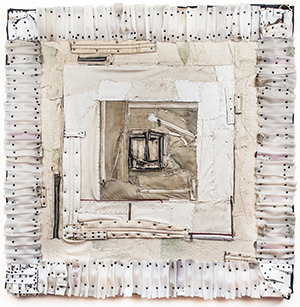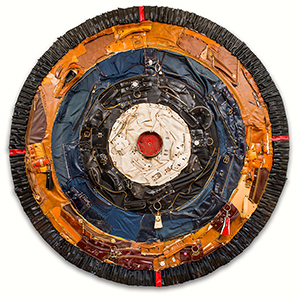
Borough of Manhattan Community College, The City University of New York (BMCC/CUNY) Assistant Professor of Art Charles McGill has been awarded a $25,000 Painters & Sculptors Grant from the Joan Mitchell Foundation.
McGill, who teaches in BMCC’s new associate degree program in Art Foundations/Studio Art, is also soon to open his first major museum exhibit, Charles McGill: Front Line, Back Nine on April 21, 2016 at the Boca Raton Museum of Art in Boca Raton, Florida.
The new exhibit will feature McGill’s assemblage pieces made from repurposed golf bags. “I get them from garage sales, the Salvation Army, Craig’s List,” he says, adding that he drives as far as Chicago to collect them.
When asked, “Why golf bags?” he explains that the attraction “is more about the hardware; the way the bags are made and the structure of all those materials: brass, steel, vinyl, the heavy nylon stitching, tempered plastic, buckles.”
It is also about the concepts imbedded in golfing, he says, as well as American history and McGill’s own experience.
The intersection of golf and art

Having earned a B.F.A. from the School of Visual Arts and an M.F.A. from the Maryland Institute College of Art, McGill was already pursuing an art career when he took up golfing with a friend, eventually working at a country club and joining their golf apprentice program.
During that time, he says, he visited a gallery with his golf bag over his shoulder, “and someone said, ‘Do you mind if I take a picture of you? I’ve never seen golf clubs in an art gallery before’.” That triggered something, McGill says, and he was inspired to introduce golfing objects into his art by reworking golf ball boxes, or sleeves, with what he describes as “racially charged images of black people in American advertising” from the 1920s and other eras.
Next, he began collaging the images onto golf bags, then progressed to deconstructing the golf bags with a handsaw; no easy feat.
“I hurt myself a lot,” says McGill. “I took my fingernail off once with a reciprocal saw. Several of the pieces actually have blood on them. I started using wire cutters, a circular saw and utility blades.”
As it turns out, he was disassembling more than leather and vinyl panels.
“For me as a black man, taking this historically ‘white’ object, repurposing it and putting another identity to it resonated on a lot of levels,” says McGill. “It’s not a coincidence that a lot of this work started right around the time that Obama took office. There was that sense of change in the country, the potential for dismantling old belief systems.”
He explains that many older golf bags are made in the South, and stamped with the name of where they’re made, on a brass plate: “They’re throwbacks to American vintage quality, and they resist coming apart.”
In the process of making of each piece, “Emotional stuff gets churned up,” he says. “The best way I can describe what happens in the studio is, it’s like sneaking up on a wild boar in the woods and trying to skin it while it’s still alive. I feel like I’m skinning these bags … Part of it might be subconscious; the idea of taking this object that has been a symbol of exclusion for a long time, and altering it to be what I want it to be.”
The impact on students
McGill’s latest work includes pieces in which the leather and vinyl is assembled into oversized bull’s-eyes.

“There is a target on black men’s backs,” says McGill, citing public backlash to change, and giving the example of Jack Johnson, who in 1908 became the first African American world heavyweight boxing champion. He links that societal resistance to “aggressive policing of black men, and backlash to Obama.”
In other pieces of McGill’s recent work, the golf bag becomes a kind of torso, topped with what he describes as “a hood; it’s Klan-like,” adding that the use of hardware in the pieces “references enslavement. A handle in the ‘chest’ of one piece suggests that the person is owned; there are all kinds of connotations.”
As an art professor at BMCC, McGill talks with students about “formal concerns I’m exploring, and personal things that I explore through that medium,” he says. To emphasize the importance of learning the basics of drawing and other techniques, he brings portfolios of his early work to class.
“I share with the beginning artists in my classes, all that crappy art from my late teens,” McGill says. “Then I show them how my art evolved after I learned some fundamentals. I make sure to remind them that the fundamentals I learned are the same fundamentals they’re learning now.” Where they take it, he says, will have to do with their own personal narrative and concepts they feel compelled to tear into.
STORY HIGHLIGHTS
- BMCC Professor of Art Charles McGill is awarded $25,000 Painters and Sculptors grant from the Joan Mitchell Foundation
- McGill’s assemblage pieces examine social issues such as racism and class
- He manually deconstructs used golf bags to create his work

